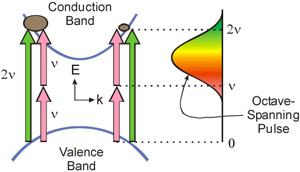Pete Roos, Tara Fortier, Xiaoqin Li, Ryan Smith, Jessica Pipis, and Steve Cundiff are using a phase-controlled mode-locked laser to control quantum processes in semiconductors. Semiconductors are capable of producing electrical currents from light (and vice-versa) and are the basis for a wide variety of optoelectronic devices, including photodiodes, light-emitting diodes, and solar cells. Light absorbed in the semiconductor promotes electrons from the valence band to the more energetic conduction band where the electrons can contribute to electrical current. JILA researchers have now shown that the current generated in some semiconductors can be sensitive to the phase of the illuminating light pulses.
The new light-phase-sensitive method is called quantum interference control. It can be viewed as a quantum mechanical analog to Young's classical double-slit experiment, in which light from a single laser passing through two slits interferes with itself, producing a pattern of light and dark lines. This interference pattern is sensitive to the phase of the light going through the two slits.
In the JILA experiment, instead of interference between two distinct spatial pathways defined by the slits, the phase sensitive current results from interference between two distinct absorption pathways between the valence and conduction bands - one-photon and two-photon absorption. The two colors of light needed to excite these two absorption pathways are actually on opposite ends of a single octave-spanning laser pulse broadened with optical fiber. The promoted electrons interfere either constructively or destructively depending on the phase of the illuminating light pulses. This produces a light-phase-sensitive current that can be measured as it flows either to the right or to the left in the semiconductor.
With more energetic green light, a single photon can promote an electron from the valence band into the conduction band (green arrows in the diagram to the right). With less energetic infrared light, it takes two photons to accomplish the same transition (pink arrows in the diagram). Quantum interference between these two absorption pathways results in a photocurrent that is sensitive to changes in the carrier-envelope phase of the laser pulses. This means the photocurrent can be used to stabilize both the mode-locked laser and the phase of the optical frequency comb it generates. The method will ultimately be used in ultrastable precision measurement.
This work on quantum interference control has been reported in a series of journal articles, the most recent of which appeared in Optics Letters on April 1, 2005. - Julie Phillips




